


Memo from Ellery Queen 1. Why was John Marco at Spanish Cape? John Marco, handsome despoiler of women, is found
murdered on the beach of Spanish Cape. This piece of land and rock juts out into the
Atlantic like some sleeping monster. It is owned by an eccentric millionaire, Walter
Godfrey. At the time of Marco's death a number of ill-assorted people are visiting at
Spanish Cape. Marco seemed to have some kind of an evil hold over these desperate women.
But strangely enough, of all the people gathered there, his was the only face that did not
wear the tense mask of dread. |
|
"Queen has a nimble wit which he uses cleverly as a means of
relieving too tense situations. It is particularly noticeable in the
dialogue."
--
Perth Daily News "Queen is a little too clever himself, readers will have difficulty in following his almost unfathomable subtleties." -- Woman's Mirror - June 1935 |
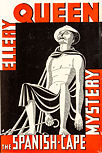 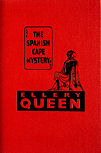 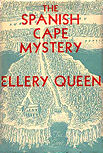  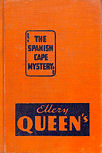   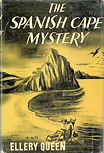 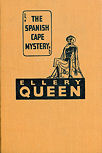 |
|
Above: The first books
published sometimes had identical front covers. The spine of the books/dust
cover only differ in the publisher's logo. Top row left to right: Both dust
cover and hard cover for Stokes, dust and two hard cover variations for Grosset &
Dunlap. Bottom row left to right: A dust cover and hard cover for Triangle Books followed another set again for Triangle Books. (Click on the covers to see the differences) * |
| Rochester Times-Union,
April 27, 1935 "New Books in brief" by Bruce Catton "Next, we come to "The Spanish Cape Mystery." Like all the Ellery Queen books, this one has about as much relation to real life as one of Horatio Alger's lesser works; it's a mathematical exercise rather than a novel, and as such it is well-constructed. A blackmailing gigolo is throttled on the beach by a country house, and he wears nothing whatever but a fussy cape. Mr. Queen puts his two and two together and bobs up with the necessary four after some ingenious thought processes." The Bulletin (Australia) - September 4. 1935 "The Spanish Cape Mystery is easily the best Ellery Queen that present murder-fan has read. In other books the master’s veneration for inordinate riches has betrayed him into irrelevancies about the lavish homes and habits of American plutocrats. Here he comes straight to the corpse (that of a blackmailing gigolo), and he reveals the secret lives of some queer men and even queerer women before the affair is cleared up. Incidentally, it mightn’t have been cleared up at all if some of the principals had taken ordinary precautions not to let their conversations be overheard." |
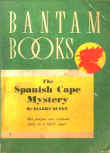 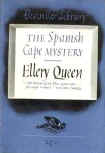   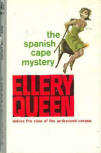    |
|
The Spanish Cape Mystery (1935) contains an ingenious solution. The strange facts about the corpse's nakedness parallels the book's predecessor, The Chinese Orange Mystery, and its reversal of everything about its corpse and crime scene. The solution also shows EQ's admirable use of logic: once EQ figures out the method of the murder, he can deduce from it the identity of the murderer, in a way that seems paradigmatic for the use of deduction in the mystery. The Spanish Cape Mystery shares a family resemblance in its plotting to The Roman Hat Mystery (1929), "The African Traveler" (1934), parts of The Devil to Pay (1938), and "Mind Over Matter" (1939). However, the solution is fairly simple, the plot is not especially complex, and the body of the book is way over long for the substance of the plot. The whole thing would be much better as a short story. |
| The book shows EQ's ability to create a natural landscape, and integrate it into a story. It seems unusual for EQ, after the urban setting and delightful floor plans of so much of his fiction. "The Treasure Hunt" (1935) of the same year also has a dramatic, isolated natural location. Such lonely buildings in inaccessible settings are a tradition in 1930's mysteries. Several were made into movies, and the lonely mansion near the sea on a dark and stormy night is a staple of the 1930's Hollywood whodunit. (Michael E.Grost) |
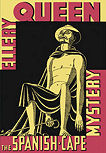      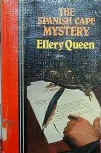 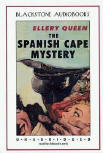  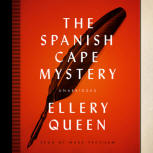 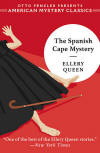 |
|
Ellery
still smokes, wears his pince-nez and uses a knife. Djuna briefly appears
and his father is only referred to. |
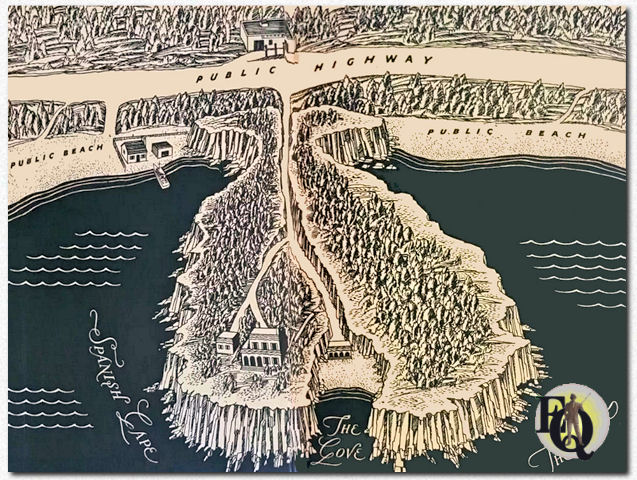 |
|
The story is set during a week on a
Spanish cape on the East Coast, situated 10 miles of Waylands amusement
park, 50 miles of St-Maartens, 2 miles north of Wye. Close to Crossley
Field. Ellery and judge Macklin drive up to the Spanish Cape. One of the important witnesses is white-overalled old Harry Stebbins, a filling-station/refreshment place proprietor. His wife Annie is an excellent housekeeper but suffers from sciatica. One wonders if the naming of this character is a tribute to Arthur B. Allen's character in radio's The Stebbin Boys which ran from 1931 to 1932.
|
|
**
Wallace (Richard Horatio) Edgar
(1875-1932) English journalist, |
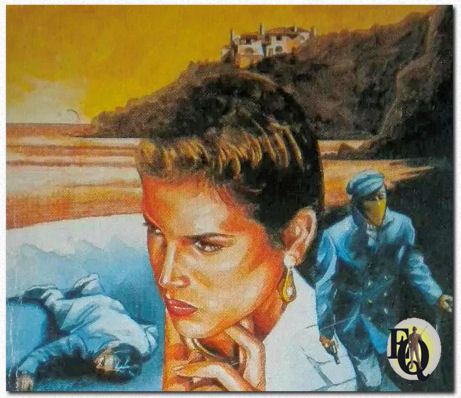 |
| Above: Detail from art work on cover
Italian edition Oscar Mondadori n.1819, 1985 Below: Detail for the Pocket Book edition artwork by Edmundo Muge. |
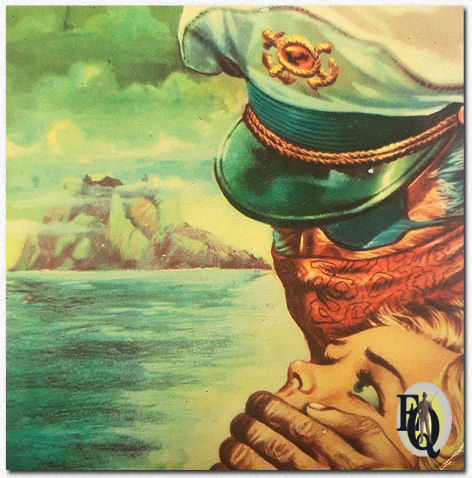 |
| Sydney Morning Herald,
May 17, 1935 "Novels of the Day" "In "The Spanish Cape Mystery" Mr. Ellery Queen has given us a technical and absorbing display of high brow detective fireworks. The tale is woven around a house party at the summer home of a wealthy American. The members of the party, though previously unknown to each other, are connected by the thread of their contact with the central character—the victim. To tell the story of the book would be to spoil the enjoyment of Mr. Queen's numerous admirers. They will not be disappointed in his latest performance. The sub-title reads "A Problem in Deduction," and there will be few readers who will close the volume finally without returning to the opening pages, to confirm or refute subtly suggested theories. The author, an enthusiastic crime specialist, joins in the hunt, and reveals, logically, and convincingly, as an eye-witness, each baffling situation. The character-drawing is sure, the descriptive passages and dialogue vivid and fluent. Mr. Queen's over-elaborate style and sometimes almost pompous egotism will no doubt antagonize some readers, but even his enemies will finish the book—perforce—and grant that it is a very good yarn." The Telegraph, Sydney July 6. 1935 "Flow of Fiction" "Mr. Ellery Queen is one of the intellectuals who have bent their literary talents to the popular cause of tickling the popular fancy with murder mystery stories. He can not only write like a stylist but can also invent plots that are ingenious and work them out with fascinating cunning. "The Spanish Cape Mystery" is probably as strong a representative of this type of fiction as one would wish to handle, and the mastery of the writing and the subtlety of the construction are equally intriguing attractions which will keep one glued to the book. A mysterious kidnapping by a gigantic ruffian, and the discovery of a man murdered and entirely naked except for a black cloak provide the story with a sufficiently startling send-off, and then we are invited to watch Ellery Queen, investigator, collaborating with the police in piecing together the history of an extraordinary crime, from bafflingly scanty clues. The scene is a palatial holiday mansion on the peculiar neck of land on the American Atlantic seaboard known as Spanish Cape, and unusual circumstances are soon shown to mark the character of the house party that the Godfreys had gathered together. There was no apparent reason for the kidnapping of David Kummer, except that he was mistaken for John Marco, who was shortly afterwards the victim of the murder. And then it transpires that Marco had forced his invitation out of Mrs. Godfrey by some process of black mail, and had compelled her to invite others nominated by him. So the mystery of the affair deepens, and we watch absorbedly the unfolding of Queen's mental workings as he proceeds by process of deduction to clear the tangles out of the situation and prepare the way for a denouement for which there is only the one word thrilling. The author is too much the artist to be guilty of sensationalism in the usual cheap sense of the mystery novel, and no one could miss the penetrating cleverness that has gone to the making of the story." |
 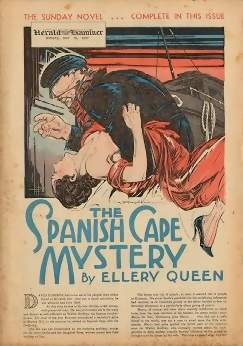 |
| Above left: Redbook
pre-publication of The Spanish Cape Mystery
(April 1935). Above right: a "Sunday Novel" from the Chicago Herald and Examiner. May 16, 1937. It is a 16 page insert, 15 pages of novel and back page advertising the next weeks novel. |
|
The Spanish Cape
Mystery Translations: |
|
Other articles on this book (1) Reading Ellery Queen - The Spanish Cape Mystery Jon Mathewson (May 2014) (2) Nudaque Veritas Ho-Ling (May 17. 2013) (3) My Reader's Block Bev Hankins (September 2. 2019) (4) Naked Death at The Chocolate Lady's Book Review Blog (November 7, 2022) (5) The Spanish Cape Mystery gaodf (June 28. 2023) |
|
*
Interested readers should know
that the icons/covers
of books, used throughout the
website have extra
descriptions/information not
included in the text on the same
page. Pointing your cursor at
the icon/cover used to reveal
this extra information. To achieve the same effect Firefox users can install an add-on called 'Popup ALT Attribute'. When installed pointing your cursor at an icon/cover results in showing you the details or additional information. |
|
Copyright © MCMXCIX-MMXXV Ellery Queen, a website on deduction. All rights reserved. |